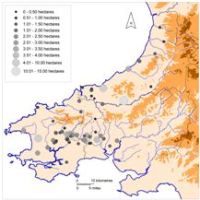

Map 7: Distribution of defended enclosures with a concentric annexe and a representation of the area of concentric annexe in hectares.
Figure 7: Bar chart showing the range and frequency of concentric annexe area in hectares.
Terry James recognised concentric annexes as a particular site type in southwest Wales through his aerial photographic work in the 1980s (James 1990). Examples of this type of site are shown on Figure 1a (for instance nos. 8386, 9683 and 11267). Since his initial work other sites have been discovered, and such sites now total 57 in number. Occasionally a bank and ditch defining a concentric annexe survive as an earthwork, but the majority only survive as cropmarks. In general, annexe ditches are slighter than the defensive ditch surrounding the main inner enclosure, survive less well, and are therefore not as easily detected on the ground or by aerial photography. It is quite likely that many more defended enclosures have concentric annexes than the 57 so far recorded. Other types of annexe have also been recognised, such as lobate enclosures and cross-banks cutting off ridge-tops, but they are a small, disparate group and are not discussed here.


Concentric annexes vary in size from less than 0.5 ha to over 10 ha, but with a clustering around the 0.51 ha to 1.5 ha size (Table 8 and Fig. 7). Map 7 shows a clustering of concentric annexes across central Pembrokeshire and western Carmarthenshire (where they were first recognised by Terry James), with very few elsewhere in southwest Wales. There is a notable absence in eastern Carmarthenshire, but this may be a result of detection (or rather the lack of it).
Table 8: Size range and frequency of concentric annexes.
| Area of concentric annexe (hectares) | No. of sites |
|---|---|
| 0–0.50 | 2 |
| 0.51–1.00 | 14 |
| 1.01–1.50 | 12 |
| 1.51–2.00 | 8 |
| 2.01–2.50 | 8 |
| 2.51–3.00 | 5 |
| 3.01–3.50 | 3 |
| 3.51–4.00 | 2 |
| 4.01–10.00 | 2 |
| 10.01–15.00 | 1 |
| Total | 57 |
A number of common traits can be identified between the examples of concentric annexes. As has already been noted, the concentric annexe defences are less substantial than those of the main inner enclosure. There is no evidence for a direct connection between the annexe and the main inner enclosure. Aerial photography and geophysical prospection show that the annexes are empty of other features (although this has not been tested by excavation), and lastly although annexes vary in size, their size is usually in proportion to the inner enclosure, with the distance between the inner ditch and the annexe ditch being normally between 45-60m.
The analysis of the function of annexes (in particular concentric annexes) to defended enclosures has not progressed since Lady Fox's interpretation of them as cattle enclosures in the early 1950s (Fox 1953). Absence of connection between the main enclosures and annexes could simply be a factor of chronology — annexes being added after construction of the main enclosure. This, however, is not an adequate explanation as the common plan of defended enclosures with concentric annexes suggests unity of planning and construction, and perhaps lends credence to Fox's interpretation of annexes as cattle enclosures. Direct contact between areas reserved for stock and the domestic settlement may not have been desirable.
The apparent absence of structures in annexes also lends support to Fox's theory. Nevertheless, there are many other possible explanations. Perhaps a form of in-field–out-field agriculture was practised, with the annexe the intensively cultivated in-field and the out-field beyond; this is a type of use that would leave little or no archaeological evidence. Alternatively, the annexe could have provided a buffer zone between the settlement and the wider world in which rituals such as processions, displays or 'sports' could have been enacted.
The average distance between the bank and ditch of the inner enclosure and the annexe bank and ditch is roughly the range of a slingshot. While it is unlikely that the purpose of all annexes was to keep enemies at a manageable distance, it is possibly true for some of the first defended settlement annexes, and it could then have become a tradition to construct it along such lines, perpetuated in later examples long after defensive considerations had passed. It is worth noting again, though, that the banks and ditches of annexes are quite slight, certainly not of defensive proportions. While this does not rule out annexes from having been cattle enclosures, cultivated fields or ritual areas (not all of which are mutually exclusive), it is unlikely that they played a major defensive function.
© Internet Archaeology/Author(s) URL: http://intarch.ac.uk/journal/issue28/1/3.6.html
Last updated: Mon Dec 14 2009